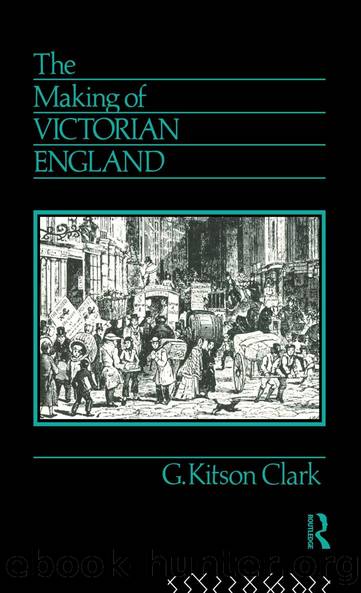The Making of Victorian England by G. Kitson Clark

Author:G. Kitson Clark [Clark, G. Kitson]
Language: eng
Format: epub
ISBN: 9780415065917
Barnesnoble:
Publisher: Taylor & Francis
Published: 1965-11-01T00:00:00+00:00
III
It would, however, do mid-nineteenth-century opinion an injustice to suggest that they only read the religious census to see how many people went to church and how many to chapel, most of them seem to have known well enough what was the most serious issue that the religious census raised. It was the problem of what Bishop Selwyn called in 1854, âthe dark masses of our uninstructed peopleâ. How vast those masses were the census had not only suggested by recording the numbers who did not go to church, it had also suggested where they were and who they were. The worst proportionate attendance at church was in Bethnal Green, where of a population of 90,193 only 6,024 attended service, but there were bad spots elsewhere and in the industrial areas north of a line between Gloucester and Grimsby only 6 out of 37 towns contrived to reach the national average of a 58 percentage of church attendance.1 In fact, the most obvious absentees were the urban working class, particularly in those great conurbations into which the great human tides of the early nineteenth century had carried them.
In spite of this it would be a mistake to think of the absentees as a uniform group, presenting a single problem. In fact, they were very diverse, their problem was complex, and different observers saw different parts of it. For instance much attention has been paid to the review of the whole matter by the Congregationalists in 1848 and to their confession that they did not seem to be able to attract the working class.2 âWhyâ, asked Mr Wells, one of the ministers whose task it was to report on the matter, âdo our new built chapels gather congregations of tradesmen, but never of artificers?â, and he gave a number of very interesting and carefully analysed answers, the gist of which was that the atmosphere of Congregational chapels had become too essentially middle class, and also too polemical on the political issues which specially interested the Congregationalists. It was a problem that continued to trouble the Congregationalists, in 1853 they are still recording the fact that âit with us is a matter of deep regret, and not less of astonishment ⦠that the artisans and working men of England are so rarely drawn within our circlesâ,1 and they had considered the matter in the intervening years. They seem to have been reasonably clear about the kind of people whom they had in mind. They were, so Mr Wells said, âgreat readersâ, but would not read Congregational literature. They were class conscious, they were anxious to gain the franchise and they were inclined to be atheists. âApart from the religious portion, our population generally may be divided into two classes mainly. The one consisting of those who are given up to low sensual indulgence, the other, of those marked by a sceptical activity of mind, disposed to question everything. A spirit of infidelity is observable, strongly working in the undercurrent of society, and festering in the workshops of our operatives.
Download
This site does not store any files on its server. We only index and link to content provided by other sites. Please contact the content providers to delete copyright contents if any and email us, we'll remove relevant links or contents immediately.
Room 212 by Kate Stewart(5016)
The Crown by Robert Lacey(4710)
Endurance: Shackleton's Incredible Voyage by Alfred Lansing(4656)
The Iron Duke by The Iron Duke(4275)
The Rape of Nanking by Iris Chang(4125)
Joan of Arc by Mary Gordon(4000)
Killing England by Bill O'Reilly(3940)
Say Nothing by Patrick Radden Keefe(3892)
I'll Give You the Sun by Jandy Nelson(3344)
Shadow of Night by Deborah Harkness(3279)
Hitler's Monsters by Eric Kurlander(3256)
Mary, Queen of Scots, and the Murder of Lord Darnley by Alison Weir(3138)
Blood and Sand by Alex Von Tunzelmann(3121)
Darkest Hour by Anthony McCarten(3058)
Eleanor & Park by Rainbow Rowell(3042)
Margaret Thatcher: The Autobiography by Thatcher Margaret(3021)
Red Famine: Stalin's War on Ukraine by Anne Applebaum(2859)
Book of Life by Deborah Harkness(2855)
The One Memory of Flora Banks by Emily Barr(2791)
